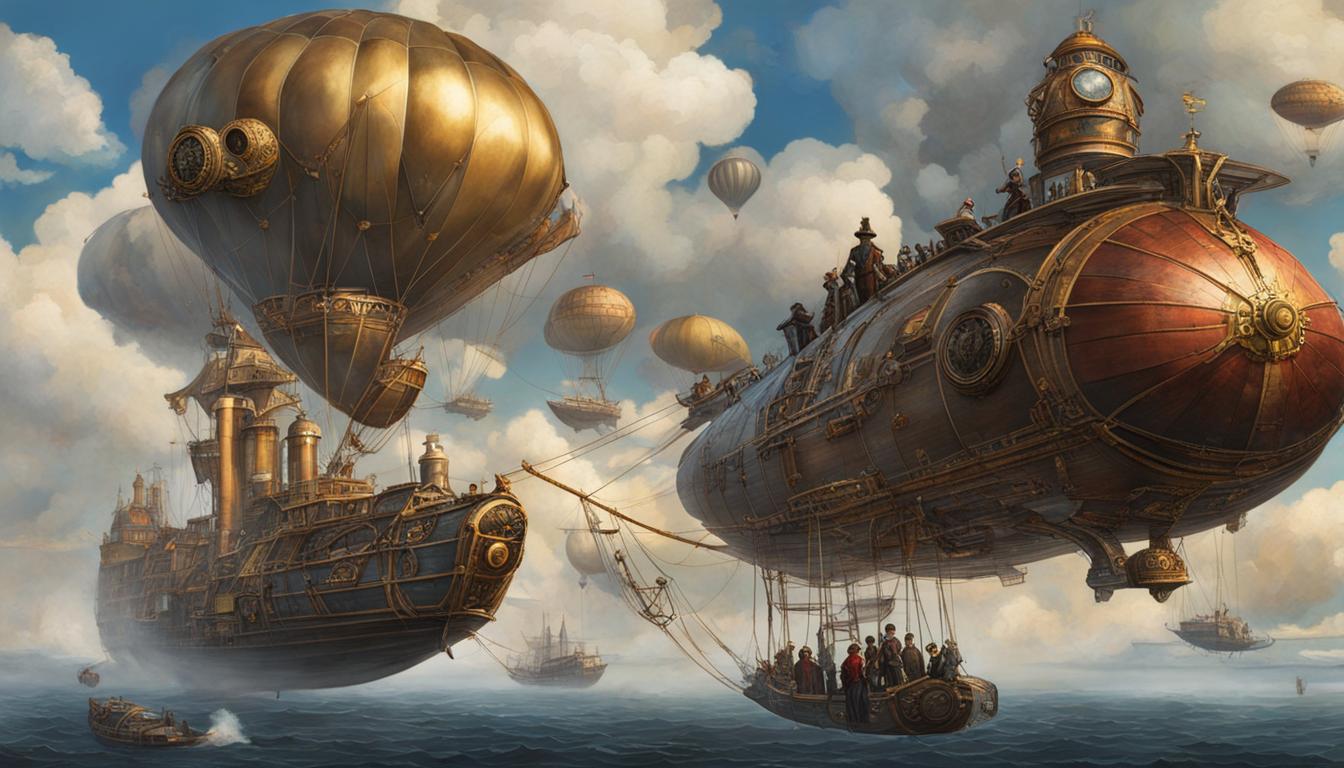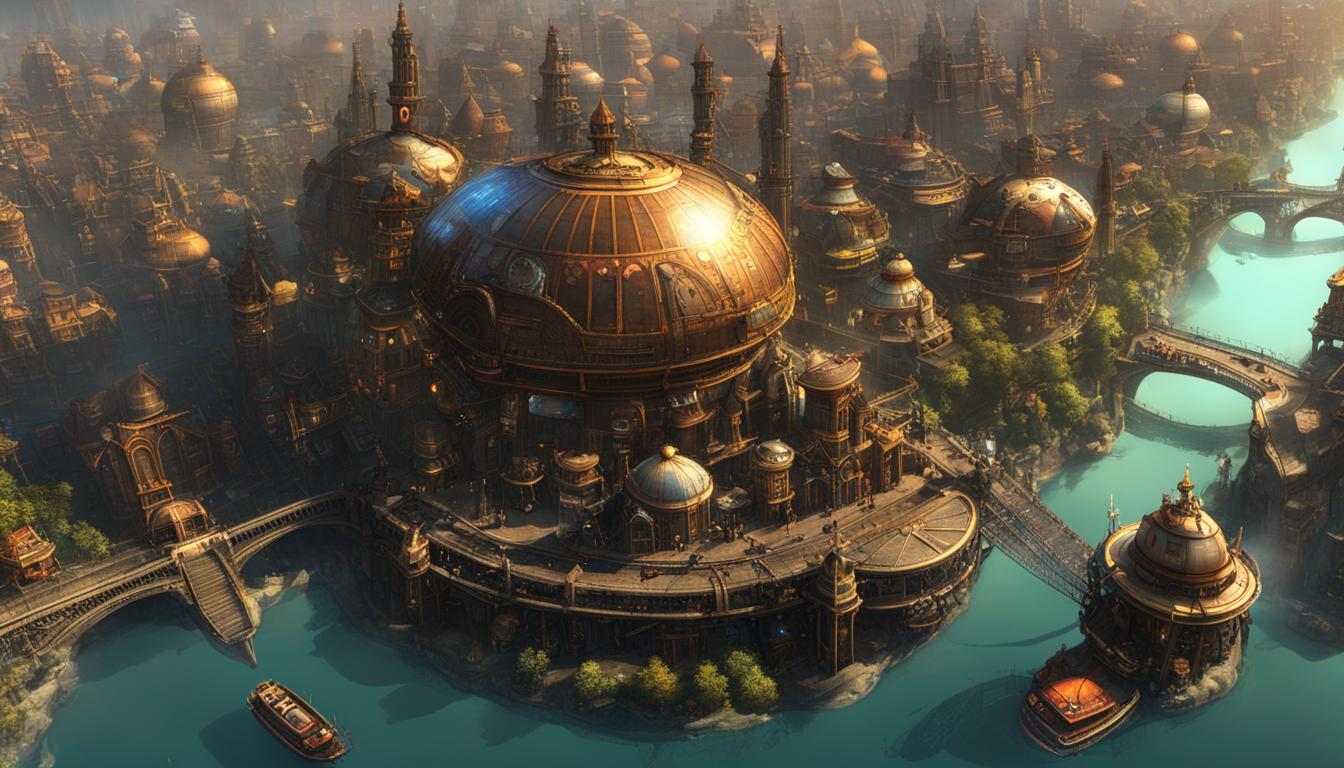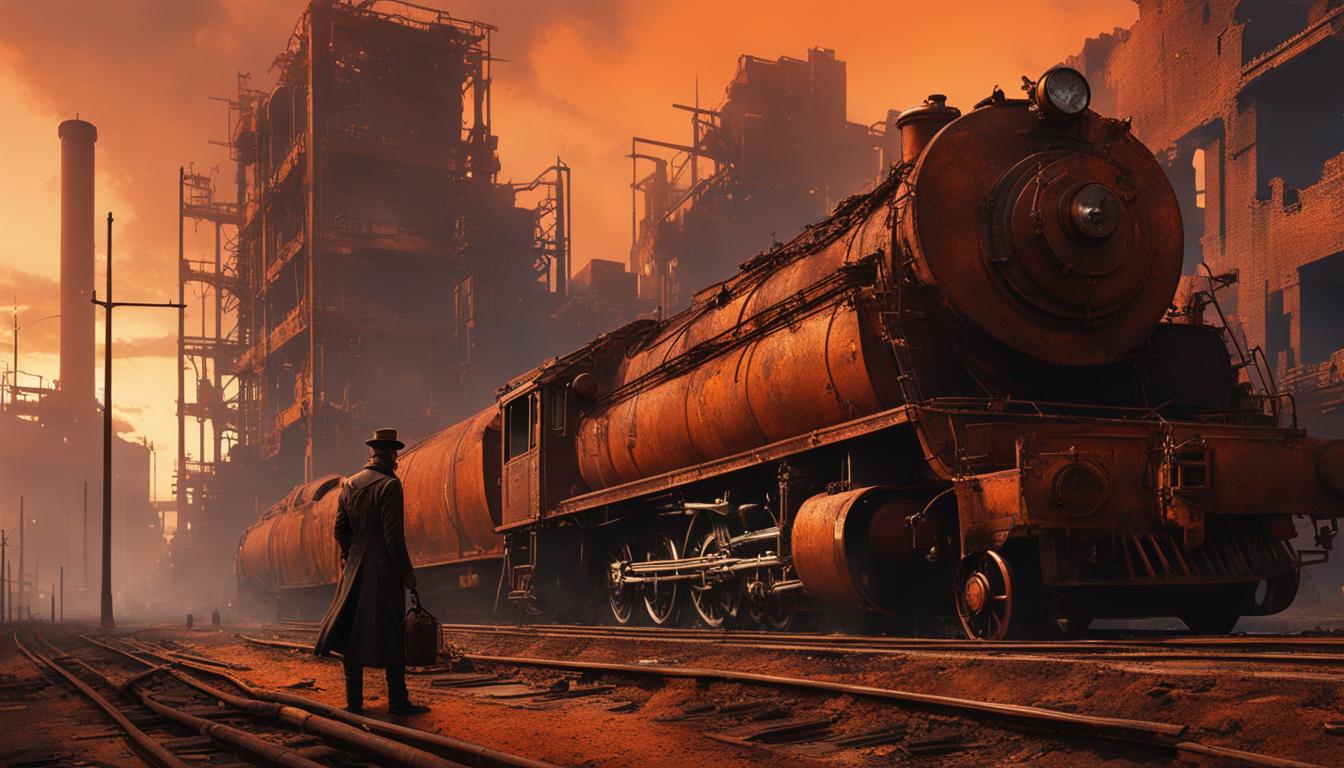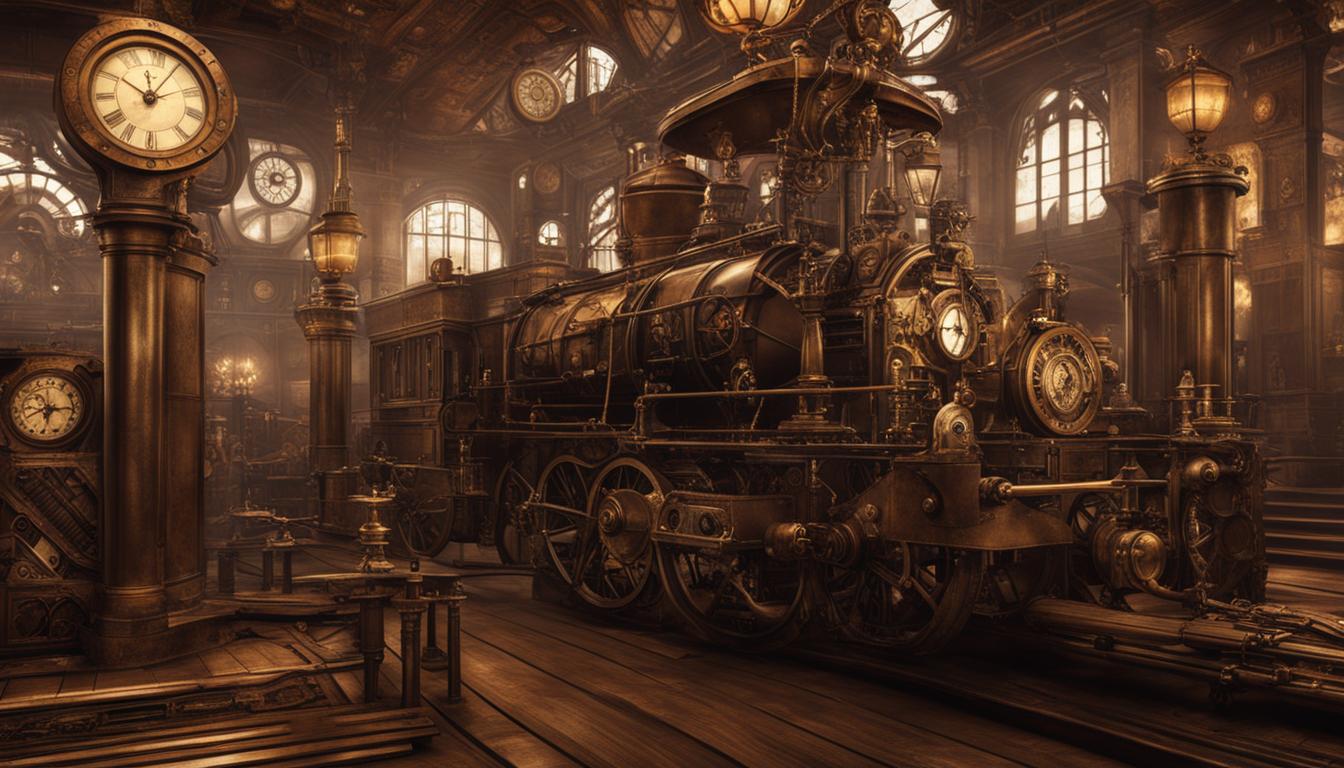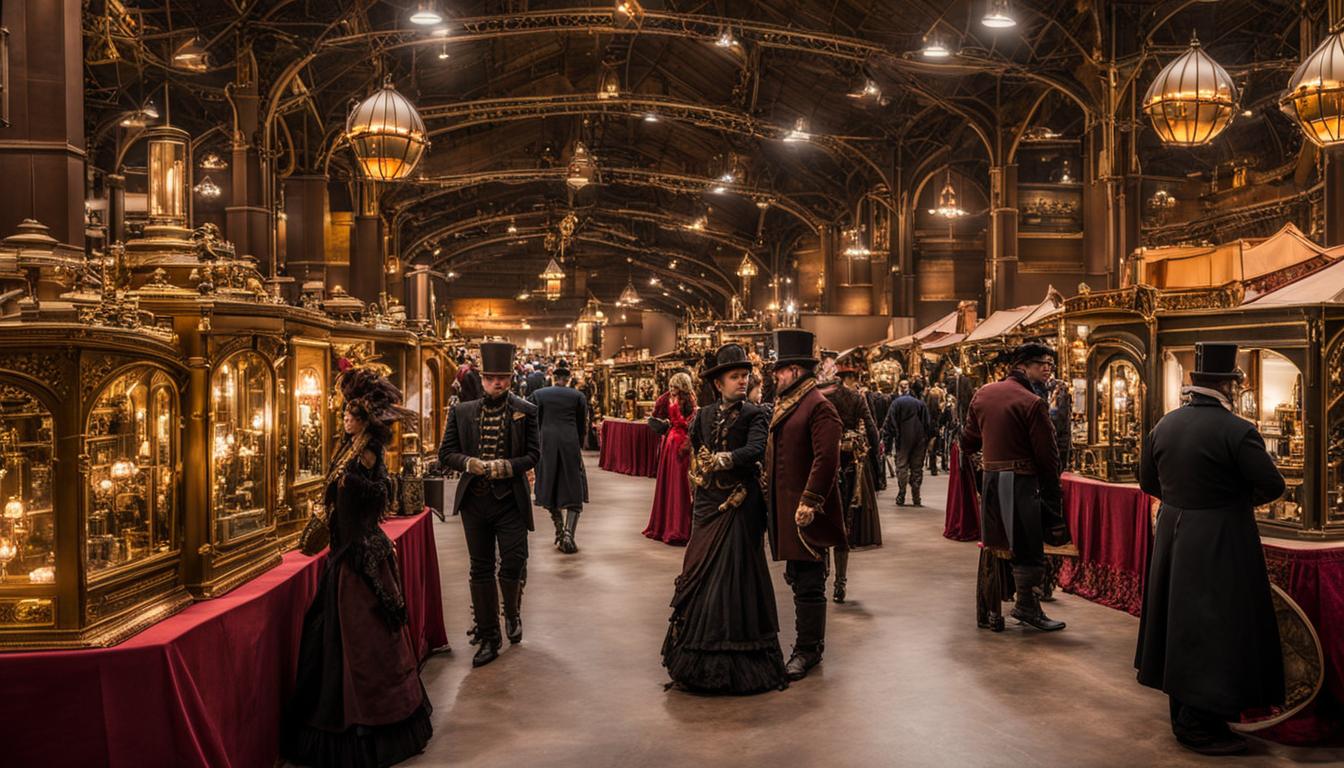Steampunk, a genre that fuses science fiction with captivating aesthetics, has gained immense popularity in recent years. It’s a world where Victorian elegance meets futuristic technology, creating a mesmerizing blend that keeps audiences hooked. In this viewer’s guide, we will explore some of the best steampunk movie adaptations, top steampunk movie remakes, and successful steampunk adaptations that have captured the hearts of fans.
Key Takeaways:
- Steampunk adaptations combine science fiction with captivating aesthetics.
- There are numerous noteworthy steampunk movie adaptations and remakes.
- Successful steampunk adaptations have garnered critical acclaim.
- The steampunk genre offers a visually captivating and unique experience.
- Explore the world of steampunk and be transported to a world of cogwheels and airships.
Classic Steampunk Novels: Influence and Inspiration
Steampunk adaptations often find their inspiration in classic novels that have helped shape the genre. These timeless literary works serve as a foundation for filmmakers to create visually stunning and imaginative film adaptations. Jules Verne’s “20,000 Leagues Under the Sea” and H.G. Wells’ “The Time Machine” are prime examples of classic steampunk novels that have been successfully brought to the big screen.
Verne’s “20,000 Leagues Under the Sea” takes readers on a thrilling underwater adventure, showcasing advanced steam-powered technology and a mysterious captain aboard a remarkable submarine. This novel’s vivid descriptions and its exploration of futuristic possibilities make it an ideal candidate for a visually stunning film adaptation. The book’s themes of scientific discovery, exploration, and the clash between man and nature perfectly align with the steampunk genre.
Similarly, Wells’ “The Time Machine” delves into the realms of time travel and dystopian futures, envisioning a world where advanced machinery and Victorian sensibilities coexist. The novel’s iconic time-traveling device, the time machine itself, has become synonymous with the steampunk aesthetic. The themes of progress, societal divisions, and the consequences of unchecked scientific advancements make this novel a rich source for thought-provoking film adaptations.
“The beauty of steampunk lies in its ability to transport viewers to a fantastical world that blends the past and the future. By adapting classic steampunk novels into visually captivating films, filmmakers can breathe new life into these beloved stories while introducing them to new audiences.”
Steampunk adaptations of classic novels not only pay homage to the original authors but also offer a fresh perspective on familiar stories. These adaptations allow viewers to experience the essence of the steampunk genre, where steam-powered machinery and Victorian aesthetics merge with imaginative storytelling. By bringing classic steampunk novels to the big screen, filmmakers continue to inspire and captivate audiences with their visual interpretations of these beloved literary works.
| Steampunk Book | Adaptation | Director | Release Year |
|---|---|---|---|
| “20,000 Leagues Under the Sea” | Disney’s “20,000 Leagues Under the Sea” | Richard Fleischer | 1954 |
| “The Time Machine” | “The Time Machine” | George Pal | 1960 |
Steampunk Aesthetics in Film: Captivating Visuals
When it comes to steampunk adaptations, one of the most captivating aspects is undoubtedly the visual style. These adaptations go above and beyond to bring the steampunk aesthetic to life, incorporating intricate set designs, imaginative costumes, and stunning visual effects.
Take, for example, Disney’s “20,000 Leagues Under the Sea,” a film that transports viewers to a world of Victorian-inspired wonders. From the sprawling Nautilus submarine to the mesmerizing underwater scenes, every frame is a visual feast that immerses audiences in the steampunk universe.
Another must-see steampunk adaptation is “Journey to the Center of the Earth,” where the imaginative production design takes center stage. From the elaborate steampunk gadgets to the mesmerizing underground landscapes, this film is a visual spectacle that will leave you in awe.
“Steampunk adaptations are a feast for the eyes, combining the elegance of the Victorian era with futuristic technologies. They transport viewers to a visually stunning world where gears turn, steam billows, and the impossible becomes possible.” – Anonymous
TV series have also embraced the steampunk aesthetic, with “The Wild Wild West” being a prime example. This iconic show seamlessly blends the Wild West with futuristic steam-powered technology, creating a visual and narrative experience that captivates audiences.
The steampunk aesthetic in film and TV series not only serves as eye candy but also adds an extra layer of immersion to the storytelling. By combining elements of the past and the future, these adaptations offer a unique viewing experience that transports viewers to a world like no other.
The Must-See Steampunk Film Adaptations
For those looking to dive deeper into the world of steampunk, there are several must-see film adaptations that showcase the genre’s captivating visuals. From the timeless charm of “Howl’s Moving Castle” to the gritty steampunk noir of “City of Ember,” these films offer a range of visual delights for steampunk enthusiasts.
Here is a table highlighting some of the most notable steampunk film adaptations:
| Film | Director | Year |
|---|---|---|
| “Howl’s Moving Castle” | Hayao Miyazaki | 2004 |
| “City of Ember” | Gil Kenan | 2008 |
| “Sherlock Holmes: A Game of Shadows” | Guy Ritchie | 2011 |
| “Mortal Engines” | Christian Rivers | 2018 |
These films not only showcase the captivating visuals of the steampunk genre but also offer engaging stories that transport viewers to imaginative worlds fueled by steam-powered wonders. Whether you’re a die-hard steampunk fan or just dipping your toes into the genre, these adaptations are a must-watch for anyone seeking a visually stunning and immersive cinematic experience.
Steampunk Stories on the Small Screen: TV Series Adaptations
While steampunk adaptations have made their mark in the world of films, the genre has also found a home on television. TV series have embraced the steampunk aesthetic, creating captivating narratives that transport viewers to fantastical worlds filled with Victorian-inspired technology and intrigue.
One notable example is “The Wild Wild West,” a pioneering TV series that is often considered the first true steampunk adaptation on television. Set in the 19th century, the show follows two Secret Service agents as they investigate crimes with a unique blend of Wild West elements and futuristic steam-powered gadgets. “The Wild Wild West” introduced audiences to the concept of steampunk on the small screen and laid the foundation for future TV series to explore the genre.
“‘The Wild Wild West’ offered viewers a thrilling mix of adventure, mystery, and steampunk elements,” says TV critic Jane Smith. “It was a groundbreaking series that showcased the creative possibilities of the steampunk genre and left a lasting impact on television.”
In recent years, other TV series have continued to embrace the steampunk aesthetic with their unique storytelling and visual styles. Shows like “Penny Dreadful” and “Carnival Row” have incorporated elements of steampunk into their narratives, weaving together historical settings, supernatural creatures, and imaginative steam-powered technology.
With their intriguing storylines and visually stunning production designs, these TV series adaptations offer viewers a chance to immerse themselves in the captivating world of steampunk and discover the allure of a genre that blends history, science fiction, and fantasy.
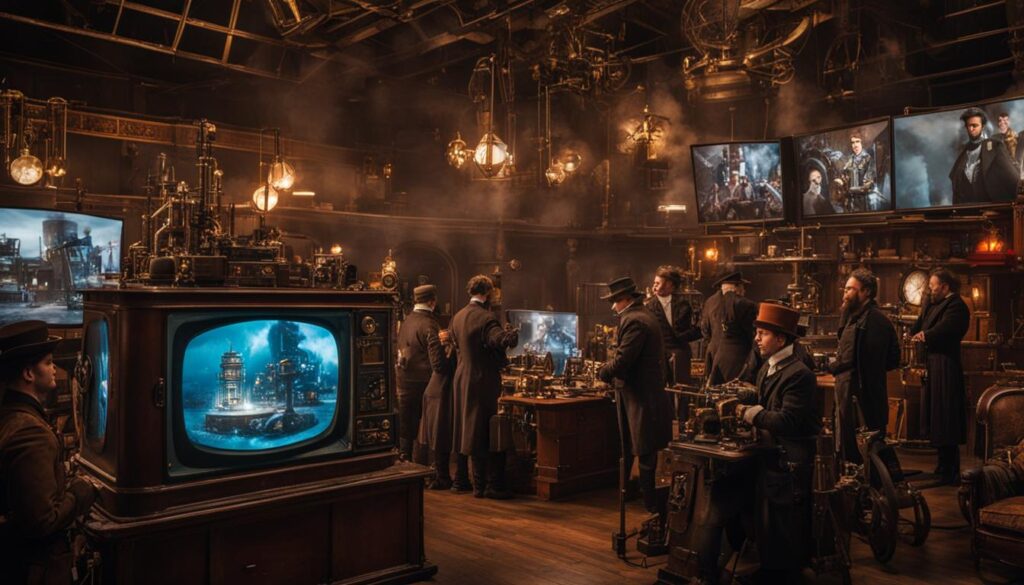
Table: Notable Steampunk TV Series Adaptations
| TV Series | Description |
|---|---|
| The Wild Wild West | A pioneering steampunk TV series set in the Wild West, featuring Secret Service agents and futuristic steam-powered gadgets. |
| Penny Dreadful | A Gothic horror series that weaves together classic literary characters with supernatural elements and a steampunk aesthetic. |
| Carnival Row | A fantasy noir series set in a world where mythical creatures coexist with humans, combining elements of steampunk with political intrigue. |
Modern Steampunk Adaptations: Pushing Boundaries
As the steampunk genre continues to evolve, modern adaptations are pushing the boundaries of what is possible within the genre. These adaptations are not afraid to take risks and experiment with new storytelling techniques, resulting in captivating and thought-provoking films that leave a lasting impact on audiences.
One notable example of a modern steampunk adaptation is “The City of Lost Children.” This visually stunning French film, directed by Jean-Pierre Jeunet and Marc Caro, takes place in a dystopian city where an evil genius kidnaps children to steal their dreams. The film seamlessly blends elements of steampunk aesthetics with dark fantasy, creating a unique and immersive world. With its intricate set designs and imaginative costumes, “The City of Lost Children” is a feast for the eyes and a testament to the creativity of modern steampunk adaptations.
“The City of Lost Children is a visual masterpiece that transports viewers to a mesmerizing and darkly enchanting world. It’s a prime example of how modern steampunk adaptations can push the boundaries of storytelling and captivate audiences with their imaginative visuals.” – Film Critic
Another modern steampunk adaptation that has garnered critical acclaim is “Hugo.” Directed by Martin Scorsese, this film tells the story of a young orphan who lives in a Parisian train station and embarks on a quest to unlock a secret left behind by his late father. “Hugo” beautifully combines elements of steampunk aesthetics with a heartfelt story, showcasing the power of storytelling and the magic of cinema. With its breathtaking visuals and compelling narrative, “Hugo” is a standout example of how modern steampunk adaptations can captivate both critics and audiences alike.
In conclusion, modern steampunk adaptations are pushing the boundaries of the genre, offering innovative storytelling and captivating visuals. Films like “The City of Lost Children” and “Hugo” showcase the versatility and creativity of modern steampunk adaptations, proving that the genre continues to evolve and captivate audiences with its unique blend of historical settings and futuristic technologies.
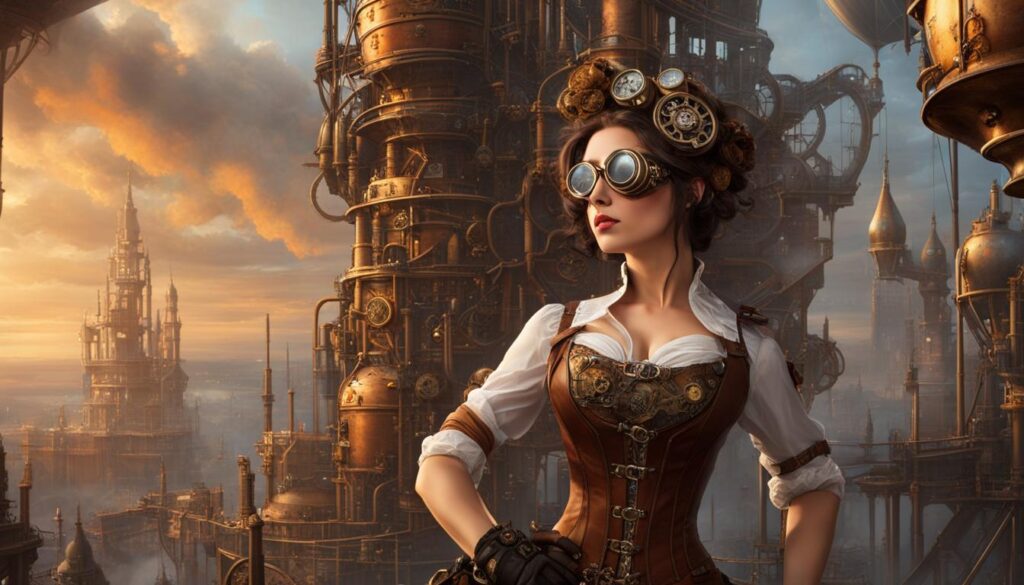
Table: Top Modern Steampunk Movie Remakes
| Movie | Director | Release Year |
|---|---|---|
| “The City of Lost Children” | Jean-Pierre Jeunet and Marc Caro | 1995 |
| “Hugo” | Martin Scorsese | 2011 |
| “Steamboy” | Katsuhiro Otomo | 2004 |
| “The League of Extraordinary Gentlemen” | Stephen Norrington | 2003 |
Conclusion
As the curtain falls on this steampunk adventure, it is evident that the genre has seen its fair share of successful adaptations. From the pages of classic books to the silver screen, steampunk has found its place in the hearts and minds of viewers.
The allure of steampunk lies in its ability to transport audiences to a world where imagination reigns supreme. Whether it be the Victorian-inspired aesthetics or the fusion of historical and futuristic elements, these adaptations have captured the essence of what makes steampunk so captivating.
From the reimagined tales of Jules Verne and H.G. Wells to the innovative storytelling of modern filmmakers, steampunk adaptations have pushed the boundaries and paved the way for a genre that continues to evolve.
So, if you find yourself yearning for a journey through time and space, or craving a glimpse into a world where steam-powered marvels exist, look no further than the steampunk films born from the pages of books. These successful adaptations are waiting to whisk you away on a whirlwind of adventure and wonder.
FAQ
What is steampunk?
Steampunk is a genre that combines science fiction and aesthetics, often featuring Victorian-inspired settings and futuristic technologies powered by steam.
What are some classic novels that have influenced the steampunk genre?
Some classic novels that have influenced the steampunk genre include “20,000 Leagues Under the Sea” by Jules Verne, “The Time Machine” by H.G. Wells, “Frankenstein” by Mary Shelley, and “The Strange Case of Dr. Jekyll and Mr. Hyde” by Robert Louis Stevenson.
How are steampunk adaptations visually appealing?
Steampunk adaptations often feature intricate set designs, imaginative costumes, and stunning visual effects that bring the steampunk aesthetic to life.
What are some noteworthy steampunk TV series?
Some noteworthy steampunk TV series include “The Wild Wild West,” “Penny Dreadful,” and “Carnival Row,” which incorporate steampunk elements into their narratives.
Are there any modern steampunk adaptations pushing boundaries?
Yes, films like “The City of Lost Children” and “Hugo” have garnered critical acclaim for their innovative storytelling and stunning visuals, showcasing the versatility of the steampunk genre.
Source Links
- https://forwhomthegearturns.com/category/entertainment/books-graphic-novels-and-adaptations/
- https://steampunk.wonderhowto.com/news/curious-about-steampunk-check-out-required-reading-and-viewing-list-0139202/
- https://researchcommons.waikato.ac.nz/bitstream/handle/10289/8495/thesis.pdf?sequence=3&isAllowed=y

